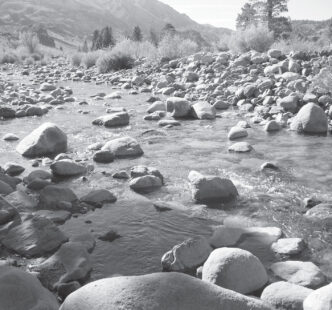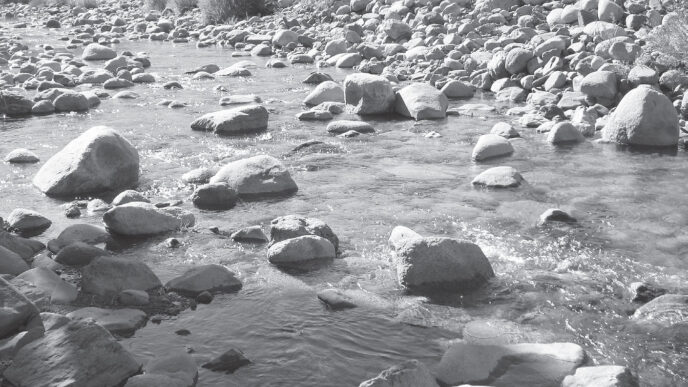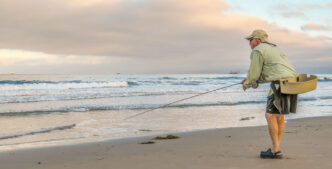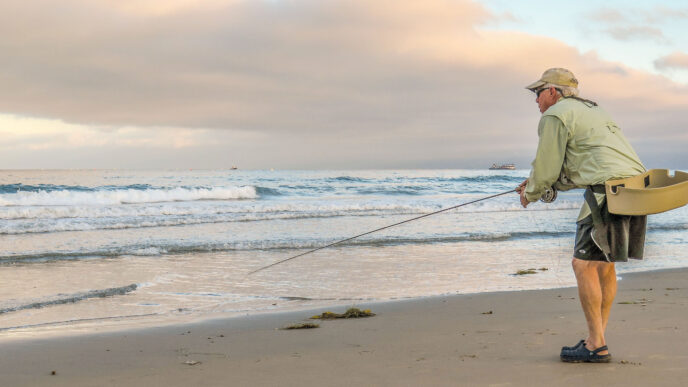From the early 1950s until the mid-1970s, fiberglass gradually took over the fishing rod market from bamboo. Fine fly rods — perhaps the finest rods available — were still being built from bamboo all during that time, but sales numbers were increasingly going to glass. Fiberglass rods were cheaper and easier to make, arguably more durable, and inarguably easier to maintain. By the mid-1960s, you had to look long and far to find a better fly rod from any material than the glass models produced by companies such as Fenwick and Phillipson, while smaller shops such as Winston, Cummings, and Peak pushed the bar even higher. By the early 1980s, however, the landscape had changed again. Rod makers and rod buyers had shifted over to graphite composite rods, and fiberglass was all but forgotten.
Graphite took over the market in large part because it offered interesting advantages over glass and to a lesser extent because it came on the market at a propitious time. Graphite is lighter and stiffer than both fiberglass and bamboo, which meant rod designers could make longer rods without them being too heavy or noodley. The 1980s were also a time when fly fishing was gaining popularity, and retail fly shops — of which there were only a few a decade earlier — were sprouting up all over the country, looking for rods and just about anything else to do with fly fishing to sell. Graphite rods, improving every year, became the bell cow leading the growth of the fly-fishing market. Whether graphite rods or new fly shops were the chickens or the eggs can be debated, but the combination of more anglers, more shops, and a new, potentially game-changing material formed a powerful conjoining of trends that drove fiberglass to the sidelines.
Forty years of graphite rod development and improvement have resulted in today’s exceptionally fine graphite fly rods. They’re no longer fragile (thank you, toughened resin systems, nanotechnology, and complex fiber layups), are offered in a dizzying array of lengths, line weights, and price points, and are almost all now routinely built in multiple sections for easy storage and transport. Twenty-five years ago, the performance difference between an inexpensive graphite rod and a top-end model was significant. Today, it’s hard to find a really bad fly rod at any price (and thank you, Korea and China, for your canny reverse-engineering work.) So, awash as we are in the best graphite rods ever built, what’s all the recent to-do about fiberglass fly rods? Are they simply zombies, neither alive nor dead, and present only to complicate our lives?
There’s certainly no scarcity of new glass rods. A partial list of rod companies that now offers glass includes Orvis, Echo, Cortland, Hardy, Cabela’s, Redington, Thomas & Thomas, Fenwick, Lamiglas, and Scott, though the last three have listed glass for a number of years. There are also custom rod crafters who specialize in building glass rods on blanks designed and made by others, and there’s a small group of builders — Tom Morgan and Mark Steffen, to name but two — who have entered the glass game with exceptional rods of their own design. (And here I’m obligated to disclose that I, too, design and build a limited number of fiberglass fly rods.)
Vintage glass rods from the 1960s and 1970s are also gaining in value, for anglers as well as for collectors. They’re to be found in the closets of older friends and relatives, at garage sales, or on the For Sale sections of numerous Web sites. Rods by Fisher, Claudio, Peak, Cummings, Scott, Winston, Phillipson, and other makers from back in the day (when was that, by the way?) are being given new lives by enthusiastic fly fishers. A look through the postings on the Fiberglass Fly Rodders Web site, www.fiberglassflyrodders.com, will lead you to an entire community of folks dedicated to glass.
The whims of fashion figure into this new interest in glass, of course. We fly fishers, who never quite solve the problems that angling presents us, seem to have an unending desire to try something new in the hope it will change the odds and turn us from duffers into experts. And glass, for fly fishers who were in diapers, rather than waders, in 1975, is nothing if not new. For older anglers, nearing retirement and sneaking uneasy glances at the obituaries while we figure out how many more years of hard fishing are left, glass represents a chance to compare what we have now with what we had then. And of course, if manufacturers perceive there’s a new market, they’re going to jump in to take advantage of it. However, while fly fishers are often gullible and too easily convinced that we can spend our way to success, most of us are anything but fools. There has to be something more to fiberglass as a rod material than novelty and nostalgia.
One friend says he likes fiberglass rods because most graphite rods feel too stiff to him. He likes to feel a rod bend when he casts and plays a fish. Fair enough. Fiberglass, to be very untechnical, is less stiff and more elastic than graphite, so it bends more and does so more easily. Even if you find a glass rod with a fast action (tip yielding, butt resisting) you’re still going to feel the whole rod bend. The nature of that bend is not simply more than that in a graphite rod, but, I’d argue, it is different, as well.

A glass rod will usually load and unload more slowly than a graphite rod as you cast. That’s due in part to the relative softness/elasticity of the material and in part to the relatively greater weight of the tip section. There can be an advantage to that slower speed in making smooth, deliberate presentations, but it does conflict with the prevailing ethos that has pervaded much of fly fishing of late: you know, the young guy in the trucker cap and wraparound shades, stalking the stream, ready to fire out a tight-looped cast and then rip some lips with a powerful strike. Sometimes that’s necessary. But when it ain’t, a glass rod can be a delight.
Other glass aficionados are convinced that glass protects light tippets better than graphite rods. One guy explained it this way:
A glass rod bends up to a point of maximum resistance and then keeps bending for a while without increasing resistance until it fails, which is rarely. Graphite bends to its point of maximum resistance and fails right there, which used to happen a lot but now happens less frequently. The thing with glass is that the distance — the angle of deflection — between minimal and maximal resistance, is longer than with graphite.
What does that mean? It doesn’t mean your 3-pound-test tippet is going to break at 4 or 5 pounds when you fish glass — that’s impossible. What breaks tippets, or more commonly, tippet-to-tippet or tippet-to-knot connections, are quick jerks or increases in pressure. What a glass rod appears to do is help you avoid them. You get to stay, for example, at 2.6 pounds pressure for a longer period of time. This “bend more without increasing pressure dramatically ” feature of glass lets you keep strong pressure on a fish while making it less likely that a sudden lunge is going to increase dramatically how hard you’re pulling and break you off. And of course, what applies to protecting very light tippets for trout also applies to fishing heavier tippets for bigger game fish.
Another accomplished angler that I know, who likes the way glass protects tippets when playing a fish, suggested that it might not be less effective on the strike than graphite. Here’s his reasoning. “When you quickly raise the rod to strike a fish, the first thing the tip section does is drop-down. It then bounces back before achieving some sort of equilibrium against a tight line. Glass, because it’s heavier, drops down farther and bounces back farther than graphite. I wonder if that bounce back doesn’t put a lot of strain on a tippet during the strike.”
Perhaps it does. But I’d argue that with kinetic energy increasing as a function of the square of the velocity, the speed with which a lightweight graphite tip bounces back generates equal or greater tippet-popping energy than a heavier, slower glass tip. I know that I break off more fish on the strike with graphite than with glass.
It is worth noting that beginning casters often do better with a faster, lighter rod than a slower one. The quicker stroke and speedier line delivery of most graphite rods, compared with the relatively slower pace of glass, provides less time to make mistakes. But what can be a disadvantage for a beginner can be an advantage for better casters: with glass, there’s more time to develop the cast and make in-the-air corrections before you stop your stroke.
But what about length? Do you have to make concessions if you prefer the feel of glass? Yes, but it might not really matter. If you absolutely need 9 feet or more of rod and a very light line, you may be disappointed, but you’ll likely be pleasantly surprised at how much water you can cover easily with an 8-foot rod. Graphite shines as a material in building long, light-line rods because it’s light and stiff. With glass, if you go too long and light, it becomes a self-deflecting noodle. There are some surprisingly good 10-foot 3-weight graphite rods, but a 9-foot 3-weight glass rod won’t win many friends. As I see it, the real sweet spot for glass is in rods for line weights 3, 4, and 5 in lengths between 7 and 8 feet or so. The material is supple enough to make delicate tip sections that can be constructively supported by well-balanced butts. The increase in rod weight over graphite is hardly apparent, though you start to sense it even for light-line rods at 8.5 feet. For 6-weight, 7-weight, and 8-weight rods, up to 9 feet is workable, but the rod’s swing weight increases the heavier you go.
A glass rod will likely weigh between a quarter of an ounce to an ounce heavier than a graphite rod of the same line weight, and the difference becomes more noticeable the longer the rod is. But what’s half an ounce to us manly men? My two favorite glass 5-weights both weigh six-tenths of an ounce more than my favorite 9-foot graphite 5-weight, though they’re 9 and 3 inches shorter, respectively. Neither rod feels noticeably heavy in hand, and two casts into the day, I observe only how pleasant they are to fish. Glass 9-weight and 10-weight rods do take more effort to cast than a comparable graphite, but once again, the increase isn’t onerous. My old Winston 9-foot glass 8-weight and 9-weight rods are rockets with both long lines and shooting heads, and I frequently choose them over a 10-foot graphite for their feel and my perception of being able to control heavy fish better. I do wear out pretty quickly with any single-handed glass rod over 9 feet, but was happily surprised at how much I liked the long f iberglass Echo switch and Spey double-handers that a friend had at the local casting ponds a few weeks ago.
But wait a minute. Aren’t rod actions that feature more bend throughout the blank also a feature of a number — though a more limited number — of graphite rods? What about, for example, Sage’s recent Circa series of slower graphite rods? Many folks, myself included, think they rival good glass and bamboo for their deliberate, measured speed, overall suppleness, and ability to deliver a light line, leader, and f ly delicately and accurately. One of the ways that Circas achieve that is with exceptionally small-diameter blanks, and my only reservation about them is that I’m not convinced that skinny butt sections offer as much control as larger-diameter butt sections before they get shaky when pulling hard on a good fish. But if a rod casts and delivers the fly sweetly, allows you that long window between minimum and maximum pressure, and that pressure is sufficient to move a fish, taper and material shouldn’t matter, right?
And that leads me to the real conclusions here. What you should fish is what you like to fish, simply because you’ll do better with it. But the wider your knowledge and experience, the better decisions you’ll be able to make about what you do like. From where I sit, you owe it to yourself to sample some good glass rods, both new and vintage, if only to understand the differences between them and modern graphite.
There are lots of good new fiberglass rods on the market, and should you be lucky enough to try one of the great old rods from glass’s too brief heyday, you may come to understand that anglers back in the 1960s and 1970s weren’t as handicapped by their equipment as many current rod marketers would have us believe.
















